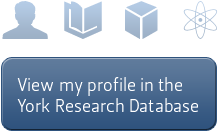Dr Tim Evans
Deputy Director
Visit Dr Tim Evans's profile on the York Research Database to:
- See a full list of publications
- Browse activities and projects
- Explore connections, collaborators, related work and more
Profile
Biography
http://orcid.org/0000-0002-2725-6730
Tim holds responsibility for all day-to-day operational issues, and along with Julian Richards has a shared responsibility for strategic development. Tim also directly manages the OASIS system, and teaches on the MSc in Archaeological Information Systems and other Postgraduate and Undergraduate courses.
----
By way of Exeter (BA) and Birmingham (MA), Tim originally started at the ADS in a short-term post designed to manage the integration of all ALSF archaeology projects , this developed into a varied role leading on larger database and web map-driven projects such as the Roman Rural Settlement of Britain [https://doi.org/10.5284/1030449]. His many and varied professional interests include semantic interoperability, Linked Data, the PDF/A standard(!), and large-scale data analysis. Thanks to his participation in the ArchAIDE project, he's also developed an (unhealthy) interest in the practical and conceptual classifications of pottery types, particularly Amphorae.
Tim's PhD was based on examining the investigative and publication histories of archaeological excavation in England. As a consequence he's developed an interest in the historiographical and epistemological foundations of archaeological practice, and the potential of unpublished fieldwork reports (so-called 'grey literature') and digital archives in dissemination strategies.
Prior to joining the ADS Tim worked in commercial archaeology for 6 years, primarily at Birmingham Archaeology (formerly BUFAU), working on a range of urban and rural sites across the West Midlands and beyond. The highlight being the multidisciplinary study at Catholme, Staffordshire [https://doi.org/10.5284/1000311]. In his younger days he also had the fortune to work extensively overseas, including excavation and survey projects in Cyprus, Italy and Egypt.
When he's not talking about himself in the third person or dealing with computers and archaeology, Tim drinks tea, enjoys watching and listening to cricket, follows the fortunes and (more often) misfortunes of Everton Football Club, and tries to complete cryptic crosswords. He's currently wondering about what really happened to the Arteta money.
Research
Overview
PhD thesis: Holes in the Archaeological Record: investigating 'unpublished' sites from modern excavations in England and the potential for the advancement and loss of archaeological knowledge
Supervisor: Professor Julian Richards
The broad research aim of this thesis is to study the phenomenon of the 'unpublished excavation' in post-war England and assess its potential impact on how archaeology is practiced in the country, from planning and guidance to research and teaching.
This broad objective includes a number of subsidiary aims, the most important of which is to provide a historical and theoretical background to the study in order to establish what is meant by 'unpublished'. It will aim, by an analysis and discussion of the available literature, to identify several key themes in modern/post-war archaeological practice and publication in England.
The thesis also aims to establish whether unpublished – and indeed published – sites can be quantified at a local or national level. It will achieve this by attempting to draw up a definitive gazetteer of all archaeological interventions undertaken in three counties (Staffordshire, South Yorkshire and Surrey), and identifying the literary output of each. By classifying these types of output at a detailed level (specifically the different types of 'grey literature') it will also study and identify cultural trends in publication. These trends may, it is hoped, provide further information regarding temporal or geographical bias for unpublished sites; for example is non-publication a problem confined to urban areas with complex stratigraphy? This will also be extended to look at the economic and social background to excavations; the comparative levels of publication from urban re-development and industry prompted excavation. Furthermore, the thesis will also aim to identify potential historical or methodological bias within the datasets studied, for example is there a difference in output between large open area excavations with high post-excavation costs as opposed to small targeted interventions?
Inherent in all this will be the continuing theme of research value: are sites published because they are typical of their type, or tell us more about a specific period or place? By the same logic, are sites not published because they are relatively unimportant? The thesis will also aim to look at the differences in publication outputs in the archaeological 'information flow', and if this has had an adverse effect on planning mitigation or research. Associated with this is the idea of archaeological 'black-holes'; is it possible that data has been lost, or is in the process of being lost, and what does this mean for archaeology as an academic discipline and as an important part of the planning process?
Research group(s)
Archaeological Information Systems

Contact details
Teaching
Undergraduate
First year
Contributor: Excavation Module
Second year
Contributor: Research Skills
Postgraduate
Module leader: Archaeological Information Systems (Digital publication and web technologies)
Contributor: Cultural Heritage Management
Publications
Selected publications
McKeague P, Corns A, Larsson Å, Moreau A, Posluschny A, Van Daele K, Evans T. One Archaeology: A Manifesto for the Systematic and Effective Use of Mapped Data from Archaeological Fieldwork and Research. Information. 2020; 11(4):222. https://doi.org/10.3390/info11040222
Anichini, F. et al. 2020 Developing the ArchAIDE Application: A digital workflow for identifying, organising and sharing archaeological pottery using automated image recognition, Internet Archaeology 52. https://doi.org/10.11141/ia.52.7
Claridge, A., Pakkanen, J. and Evans, T. (2016) Laurentine Shore Project (Castelporziano, Rome). Papers of the British School at Rome 84, pp. 307–320. https://doi.org/10.1017/s0068246216000222
Evans, T.N.L. (2016) Twilight over England? Archaeological Excavation in England 1938–1945. European Journal of Archaeology 19(2), pp. 335-359. https://doi.org/10.1179/1461957115y.0000000013
Evans, T.N.L. (2015) A Reassessment of Archaeological Grey Literature: semantics and paradoxes. Internet Archaeology 40. https://doi.org/10.11141/ia.40.6
Evans, T.N.L. and Moore, R.H. (2014) Beyond the 'Preserving Machine': Promoting Use and Reuse of Grey Literature and Grey Data. Archaeological Review from Cambridge 29.2, pp.226-243.
Evans, T.N.L. and Moore, R.H. (2014) The Use of PDF/A in Digital Archives: A Case Study from Archaeology. International Journal of Digital Curation 9:2, pp. 123-138. doi:10.2218/ijdc.v9i2.267
Evans, T.N.L. (2014) An Undiscovered Country? A History of Archaeological Investigation in Post-War England. Insights provided by Digital Resources'. In: Clare Mills, Michael Pidd and Esther Ward. Proceedings of the Digital Humanities Congress 2012. Studies in the Digital Humanities. Sheffield: HRI Online Publications, 2014. Available online.
Evans, T.N.L. (2013) Holes in the Archaeological Record? A Comparison of National Event Databases for the Historic Environment in England. The Historic Environment 4:1, pp. 19-34.
Moore, R.H. and Evans, T.N.L. (2013) Preserving the Grey Literature Explosion: PDF/A and the Digital Archive. Information Standards Quarterly, 25:3, pp. 20-27. doi:10.3789/isqv25no3.2013.04

